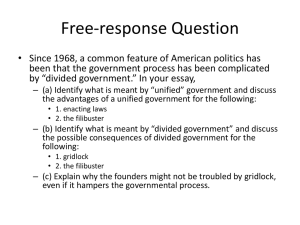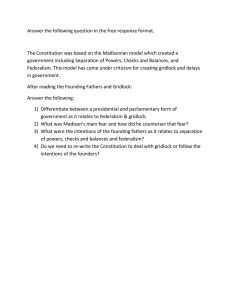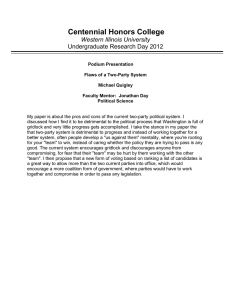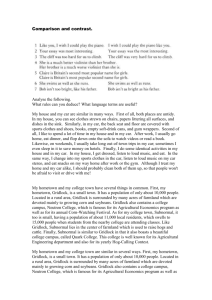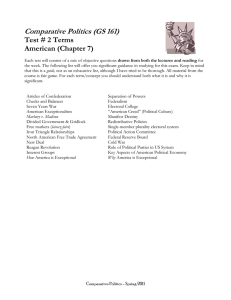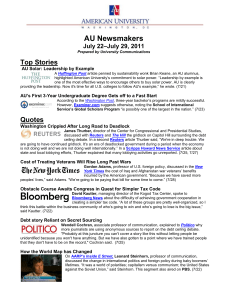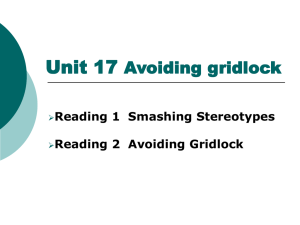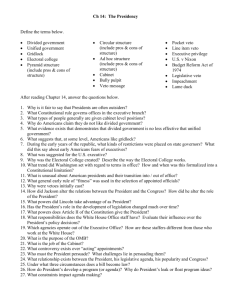Gridlock economy 49.02 No ChangeThis
advertisement
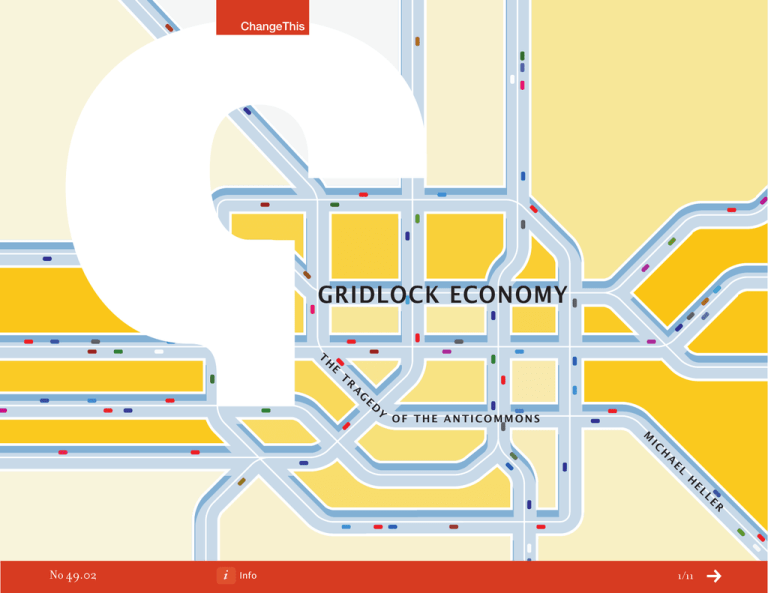
ChangeThis Gridlock Economy T h e T r ag ed y of the Anticommons M ic h a el H el le r No 49.02 Info 1/11 ChangeThis 1. Gridlock Puzzles A few years ago, a drug company executive presented me with an unsettling puzzle. His scientists had found a lifesaving cure, but they couldn’t bring it to market unless the company bought access to dozens of patents. Any single patent owner could demand a huge payoff; some blocked the whole deal. This story does not have a happy ending. The drug sits on the shelf, even though it might have saved millions of lives and earned billions of dollars. Here’s a second high stakes puzzle: what’s the most underused natural resource in America? The answer may be a surprise. It’s the air waves. Over 90% is dead air because ownership of the broadcast spectrum is so fragmented. As a result, our information economy is hobbled. Wireless broadband coverage in America lags far behind that in Japan and Korea. The cost of spectrum gridlock measures in the trillions. And another: why do we waste weeks of our lives stuck in airports? Real estate gridlock. Air travel was deregulated thirty years ago. The number of fliers has tripled. So how many new airports have been built in America since 1975? One. Denver. You can’t build new airports, not anywhere, because multiple landowners can block every project. Twenty-five new runways at our busiest airports would end most routine air travel delays in America. Why is African American farm ownership 98% lower, 98% lower, today than a hundred years ago? What caused the potato famine that starved a million people to death in Ireland? How come we can’t get clean wind energy from Texas, where it’s windy, to the coasts where people actually want green power? No 49.02 Info 2/11 ChangeThis 2. A Free Market Par adox All of these puzzles share a common cause. Private ownership usually creates wealth. But too much ownership has the opposite effect—it creates gridlock. When too many people own pieces of one thing, cooperation breaks down, wealth disappears … everybody loses. Gridlock is a free market paradox. There has been an unnoticed revolution in how we create wealth. In the old economy, ten or twenty years ago, you invented a product and got a patent; you wrote a song and got a copyright; you subdivided land and built houses. Today, the leading edge of wealth creation requires assembly. From drugs to telecom, software to semiconductors, anything high-tech demands the assembly of innumerable patents. And it’s not just high tech that’s changed—today, cutting edge art and music is about mashing up and remixing many separately-owned bits of culture. Even with land, the most socially-important projects, like new runways, require assembling multiple gridlocked parcels. Innovation has moved on, but we are stuck with old-style ownership that’s easy to fragment and hard to put back together. Fixing gridlock will inevitably be a key challenge for our time. Some solutions are entrepreneurial. For example, people can profit from finding creative ways to bundle ownership. Philanthropists can assemble patents to cure diseases. Political advocacy will be a needed solution. But the first and most important step to solving gridlock is to name it and make it visible. With the right language, anyone can spot links among gridlock puzzles, and we can all come together to fix them. No 49.02 Info 3/11 ChangeThis 3. The Tr agedy of the Anticommons Here’s the language you need to know. All the gridlock puzzles result from a principle I call the tragedy of the anticommons. What’s that? Start with something familiar: a commons. When too many people share a single resource, we tend to overuse it—we over-fish the oceans and pollute the air. This wasteful overuse is a tragedy of the commons. How do we solve such a tragedy? Often, by creating private property. Private owners tend to avoid overuse because they benefit directly from conserving the resources they control. When too many people share a single resource, we tend to overuse it—we over-fish the oceans and pollute the air. Unfortunately, privatization can overshoot. Sometimes we create too many separate owners of a single resource. Each one can block the others’ use. If cooperation fails, nobody can use the resource. Everybody loses. Consider the example of a brother and sister who jointly inherit the family home. “All of us as parents want to believe our children will be friendly when we’re gone,” says an estate planning expert, but leaving the house to the kids is “a sure recipe for disaster.” One wants to rent the house out; the other, tear it down. If they can’t strike a deal, neither can move forward. The house sits empty. That’s gridlock. No 49.02 Info 4/11 ChangeThis Now imagine twenty or two hundred owners. If any one blocks the others, the resource is wasted. That’s gridlock writ large—a hidden tragedy of the anticommons. I say “hidden” because underuse is often hard to spot. For example, who can tell when dozens of patent owners are blocking a promising line of drug research? Innovators don’t advertise the projects they abandon. Lifesaving cures may be lost, invisibly, in a tragedy of the anticommons. Since I coined the term tragedy of the anticommons, the idea has taken root and started spreading. In 2001, Nobel Prize winner in economics James Buchanan and colleague Albert Yoon proved my anticommons hypothesis mathematically. They wrote that the concept helps explain “how and why potential economic value may disappear into the ‘black hole’ of resource underutilization.” In 2006, business school researchers discovered that people do worse negotiating anticommons dilemmas than identical tasks framed in tragedy of the commons terms. Why? Perhaps because the dynamics of underuse are still so unfamiliar. Now, business schools are starting to teach future MBAs how to recognize and resolve gridlock. Policy makers are picking up the idea as well: both conservatives focused on misregulation and liberals concerned with excessive privatization. No matter where you stand, all can agree that gridlock is a losing game. No 49.02 Info 5/11 ChangeThis 4. Discovering Gridlock. I first glimpsed the paradox of too many owners with my forehead frozen to a Moscow shop window and my mind desperately casting about for something halfway intelligent to report to Igor Gaidar, Russia’s deputy prime minister for economic reform. Back when the Soviet Union was crumbling, I flew to Moscow for the World Bank. Standing on a podium before billowing red bunting and an oversized statue of Lenin, I addressed Moscow’s Supreme Soviet on how to create markets in land and housing. Destroying private property was simple; re-creating it from scratch, much trickier. As the joke went, anyone can turn an aquarium into fish soup, the challenge is turning soup back into an aquarium. First you define private ownership, then create owners, then . . . As the joke went, anyone can turn an aquarium into fish soup, the challenge is turning soup back into an aquarium. The transition from Marx to markets went quickly, but not always well. At one point, Gaidar posed a puzzle for my team. A year after his government had privatized storefronts, shelves still remained bare. By contrast, on the freezing sidewalks, thousands of flimsy metal kiosks offered everything imaginable. Gaidar asked, “Why don’t the merchants come in from the cold?” Moscow was cold that winter: minus forty degrees, the only temperature at which the Fahrenheit and Celsius scales converge. Still, Muscovites lined up at kiosks for bread and flowers while I peered No 49.02 Info 6/11 ChangeThis into empty stores and talked with Moscow merchants. I learned it was easy to set up a kiosk. Just bribe a few officials and pay a mafia gang for protection. Opening a store was more difficult. When Russia privatized commercial enterprises, it split ownership among too many parties, any one of whom could block use—and did. Oddly, one new owner had the right to sell the store; a second, the right to lease; and a third, the right to occupy the same store. Looking into those empty stores was my first glimpse, quite literally, of a gridlock economy. In the years since I discovered this market dynamic, a thousand scholars have tested, verified, and extended the concept. The gridlock paradox is a simple idea but it explains a lot. Empty Moscow stores may seem far away, but missing drugs, slow wireless, air travel delays, and a near-infinity of everyday puzzles share this common cause—one whose solutions could jump-start innovation, release trillions in productivity, and help revive our slumping economy. No 49.02 Info 7/11 ChangeThis 5. Sub-Prime Gridlock Today Today, the sub-prime mortgage crisis that’s hit the economy so hard has its roots in gridlock. As a result, the big investment bank Bear Stearns collapsed in March and falling real estate prices may tip the economy into recession. But, the gridlock angle that helped cause the current crisis hasn’t even been reported. Not long ago, mortgage bankers sized up borrowers before making loans; lenders were a phone call away if homeowners had trouble repaying. Not anymore. Investment banks engineered a mortgage market for people with weak credit. Banks pooled these mortgages together, and then split the pools into bonds with varying risk levels. The details were complex, but the results magical: the financial engineering seemed to transform dodgy mortgages into safe bonds. So long as real estate values kept rising, everyone made money. Today, the sub-prime mortgage crisis that’s hit the economy so hard has its roots in gridlock … But, the gridlock angle that helped cause the current crisis hasn’t even been reported. No 49.02 Info 8/11 ChangeThis But fragmenting mortgage ownership broke the link between borrower and lender. When house prices dropped, the gridlock features of the new financial instruments came to the fore. There were too many bond owners, no one of whom was motivated to act like an old-fashioned mortgage banker. In the old days, not so long ago, lenders worked hard with borrowers to rescue troubled loans. With foreclosure, everybody loses, even the banks. In the new world of innumerable bond owners, each can block restructuring of repayment terms. Costly foreclosures became inevitable. There’s a regulatory gridlock story here as well. Mortgage regulation is still based on the old, onemortgage, one-banker model. (It’s the real estate analogue to the one-product, one-patent model that makes high tech innovation so difficult.) New financial instruments fall between multiple federal and state regulators. No single agency can protect the integrity of the financial system as a whole, but each is powerful enough to block the others from stepping on its bureaucratic turf. Fragmented regulation means no one checked as hundreds of billions in bad bonds were sold to investors. The mortgage crisis is being sorted out. Congress will likely pass some foreclosure relief measure. My point in raising the issue is not to focus on yesterday’s crisis. It’s to say that whatever is in the news, look for the gridlock angle. Too many owners means too little prosperity. No 49.02 Info 9/11 ChangeThis Nothing is inevitable about gridlock. 6. Our Gridlock Economy. While writing The Gridlock Economy, I encountered examples of gridlock battlegrounds all around— ranging from tales of medieval robber barons to modern day broadcast spectrum squatters; from Mississippi courts selling African-American family farms to troubling New York City land confiscations; from Chesapeake Bay oyster pirates to today’s gene patent and music mash-up outlaws. Every example offers insights into how to spot gridlock in operation and how to overcome it. Who should give a damn about gridlock? Anyone who wants to assemble resources for positive change, get a jump on next generation innovation, or simply understand the hidden workings of everyday life. Nothing is inevitable about gridlock. Every example results from choices we make, and can change, about how to control the resources we value most. We can begin to unlock the grid once we know where to start. No 49.02 Info 10/11 ChangeThis info About the Author Michael Heller is Vice Dean for Research and Lawrence A Wein Professor of Real Estate Law at Columbia Law School. Since is original article on the topic in a998, his articles and presentations on the anticommons have described its implications on patent law, copyright, property rights, environmental law, cyberspace, AfricanAmerican history, Native American politics, and the transition to a market economy in formerly socialist states. He has advised the governments of Russia, Poland, Hungary, Romania, Albania, and Armenia on property rights, and also written on property conflicts in Israel, China, Honduras, and other countries. He lives in New York City and Los Angeles. send this Pass along a copy of this manifesto to others. buy the book Get more details or buy a copy of Michael Heller’s The Gridlock Economy. Subscribe Sign up for our free e-newsletter to learn about our latest manifestos as soon as they are available. Born on date This document was created on August 6, 2008 and is based on the best information available at that time. Check here for updates. ABOUT CHANGETHIS Copyright info WHAT YOU CAN DO ChangeThis is a vehicle, not a publisher. We make it easy for big ideas to spread. While the authors we work with are responsible for their own work, they don’t necessarily agree with everything available in ChangeThis format. But you knew that already. The copyright of this work belongs to the author, who is solely responsible for the content. You are given the unlimited right to print this manifesto and to distribute it electronically (via email, your website, or any other means). You can print out pages and put them in your favorite coffee shop’s windows or your doctor’s waiting room. You can transcribe the author’s words onto the sidewalk, or you can hand out copies to everyone you meet. You may not alter this manifesto in any way, though, and you may not charge for it. ChangeThis is supported by the love and tender care of 800-CEO-READ. Visit us at 800-CEO-READ or at our daily blog. No 49.02 Info This work is licensed under the Creative Commons Attribution-NonCommercialNoDerivs License. To view a copy of this license, visit Creative Commons or send a letter to Creative Commons, 559 Nathan Abbott Way, Stanford, California 94305, USA. Cover image from iStockphoto® 11/11
